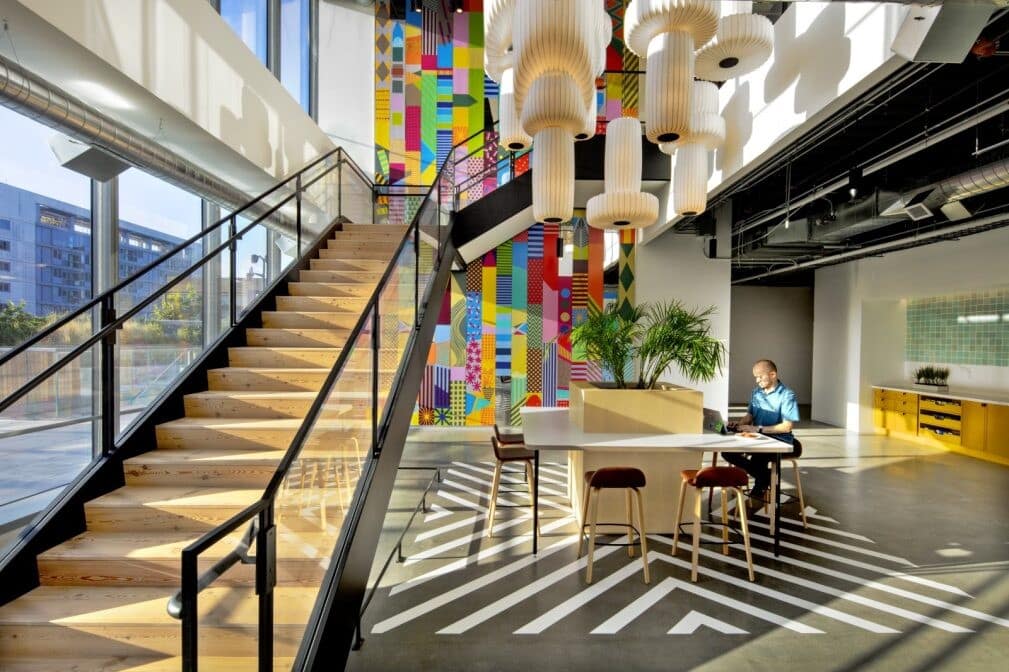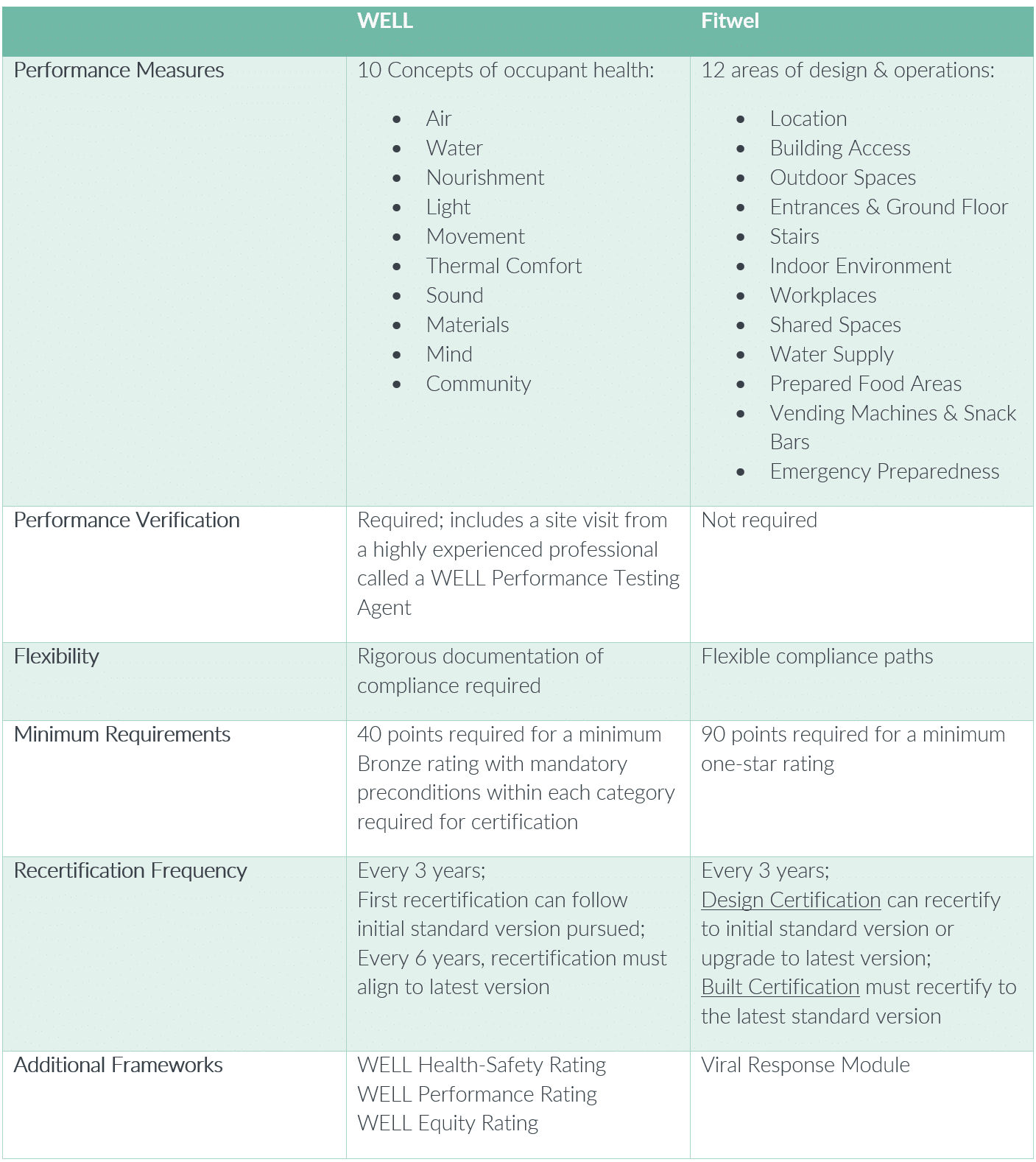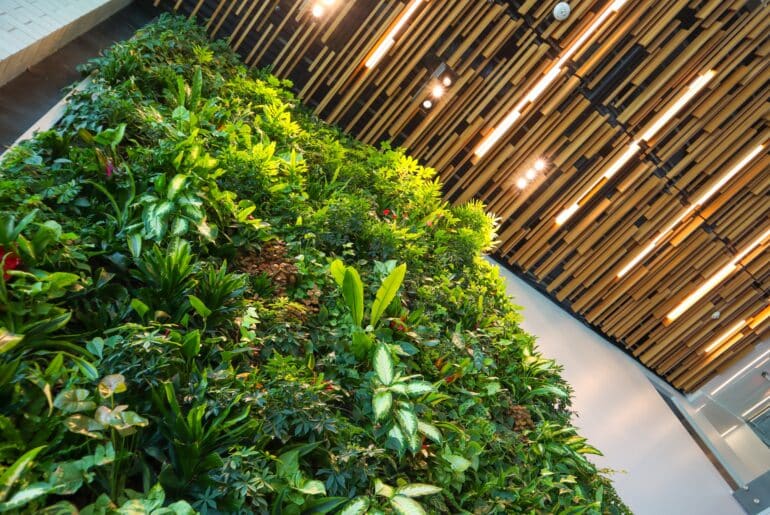If you’re considering how to design your space for the health and well-being of occupants, you’ve likely encountered WELL and Fitwel. Despite the banter about competition, we’re not-so-secretly thrilled to have two robust frameworks to use when designing real estate solutions for people. They both are impactful in the right context, and despite their human-centric design roots, should be viewed as an apples-to-oranges comparison.
WE’LL START WITH THE HISTORY
WELL was developed over 10 years ago by Delos, a well-being real estate and technology firm, and is managed and administered by the International WELL Building Institute (IWBI), a public benefit corporation. The WELL Building Standard is third-party certified by the Green Business Certification Incorporation (GBCI), which administers the LEED certification program and the LEED professional credentialing program. It’s a system for scaling health across an organization by measuring, certifying, and monitoring features of the built environment that impact human health and well-being through air, water, nourishment, light, movement, thermal comfort, sound, materials, mind, and community.
Fitwel was developed in 2016 by the CDC (Centers for Disease Control) and the General Services Administration (the government agency that runs federal office buildings). It’s operated by the Center for Active Design (CfAD), a non-profit entity. It’s a framework aimed at helping organizations scale health across their real estate portfolio by evaluating all the design factors, policies, and operations that go into creating a healthy indoor environment, from proximity to public transit, bike parking, indoor air quality, healthy food and water access, stairwell design, and emergency preparedness.
ON TO THE SCOPE, STRINGENCY, AND EASE OF USE
WELL sets performance requirements across ten concepts relevant to occupant health in the built environment: Air, Water, Nourishment, Light, Movement, Thermal Comfort, Sound, Materials, Mind, and Community. The current version is WELL v2.
The scientific rigor of WELL is unquestionable, and although it can be cumbersome, it results in positive human health impacts, which also yields a great ROI on human capital investment through increased worker productivity and decreased absenteeism.
Complex documentation must be gathered for WELL, including annotated project documents, drawings, policies, operations plans, and letters of assurance from the project team. Performance Verification is required and includes a site visit from a highly experienced professional called a WELL Performance Testing Agent, where visual inspections and performance tests to evaluate air and water quality, noise, light and temperature levels, and other environmental parameters may be performed. Upon completion of Performance Verification, the project receives a WELL report that provides a feature-by-feature assessment of WELL requirements. Because the WELL standard highly values ongoing performance of the building throughout its lifetime, a project must re-certify their building(s) every three years to ensure it is still performing as originally designed (the first recertification can certify to the standard version initially pursued, however, at the second recertification a project must certify to the current standard version; the same goes for every six years/every two recertifications).
WELL is designed for all building typologies, but is primarily recognized for its use in commercial office space, and has different requirements for owner-occupied buildings (the project is mainly occupied by the project owner, which may be different than the building owner) and WELL Core (the project owner occupies a small portion of the project area and rents/leases most of the space to one or more tenants). Hot tip: You’ll get the most bang for your buck if you apply WELL to commercial interiors or projects where occupants are present given all the quality assurances and testing applies directly to their environment and has a positive impact on their well-being.
WELL developed a handful of other frameworks including the WELL Health-Safety Rating, the WELL Performance Rating, and the WELL Equity Rating. The WELL Health-Safety Rating is a roadmap for organizations to anticipate what’s around the corner and put the necessary plans and protocols in place for resilience and response.

Fitwel measures health within 12 areas of design and operations: Location, Building Access, Outdoor Spaces, Entrances and Ground Floor, Stairs, Indoor Environments, Workspaces, Shared Spaces, Water Supply, Prepared Food Areas, Vending Machines and Snack Bars, and Emergency Preparedness. The current version is Fitwelv2.1; however, CfAD is launching v3 on December 15, 2023.
Fitwel is also grounded in scientific research. The standard was generated by expert analysis of over 5,600 academic research studies.
Although there are more categories in Fitwel than in WELL, the system allows for more flexible and less rigorous compliance paths. For example, it encourages daylighting, but doesn’t require the measurement of lumens. This flexibility makes Fitwel more accessible than WELL in many ways, but it could also result in a space that doesn’t reach the same performance outcomes as a WELL certified building.
Fitwel can be applied to various buildings and sites, such as communities, commercial or industrial sites, senior housing, workplaces, retail buildings, and multifamily residential buildings. There are two certification pathways: Built Certification (existing buildings/post-occupancy) and Design Certification (new buildings/prior to occupancy). Hot tip: It’s advised to review Fitwel’s Submission Workbook to map your building typology to the appropriate Fitwel Site or Building scorecard at the onset of the project and before benchmarking.
To pursue Fitwel, a user can register a building or site, complete the Fitwel Scorecard using an online portal, and gain a numerical score for a project immediately. This score provides benchmarks allowing users to make improvements. Certification is optional and can be pursued at any point by uploading documentation for review. Similar to the WELL standard, Fitwel is designed mainly for commercial office buildings, and has different requirements for multi-tenant buildings, single-tenant buildings, and commercial interiors spaces. Additionally, recertification is required every three years, and your project will be certified under the standard version initially pursued. (Note: Design Certification projects have an option to upgrade to the current standard version for recertification. Built Certification projects must recertify under the current standard version.)
Fitwel developed an additional framework called the Viral Response Module, which is intended to mitigate viral transmission within the built environment. It can be thought of as a “return to office” strategy framework following an epidemic or pandemic.

AND FINALLY, THE COST
WELL certification and WELL Core have an enrollment fee of $3,000 and certification is $0.16 and $0.08 per square foot (starting at $6,500 and capped at $98,000), respectively. There are various discounts, including tenants in WELL Certified Core buildings save 20-35% for projects in emerging markets and certain sectors, as well as discounts for IWBI Keystone and Cornerstone members. For organizations looking to achieve multiple certifications and ratings, IWBI’s WELL at Scale program provides an efficient, streamlined process that saves time and money. The rigor and complexity of WELL typically requires the engagement of an external consultant.
Fitwel has a project registration fee of $500 and certification fees vary depending on the type and size of the project. Site scorecards are based on acreage, starting from $14,000, and building scorecards are based on square footage, starting from $6,500 to $13,000+. Fitwel offers reduced pricing for companies looking to commit to Fitwel at scale. The system is designed to be simple enough for those who own or occupy buildings to achieve certification without engaging an external consultant; however, an experienced consultant can ensure the process goes smoothly, resulting in fewer review comments and less time spent on the documentation process.

THE CONCLUSION?
Fitwel is an accessible, affordable, and highly practical starting point for benchmarking and optimizing a space for occupant health. By contrast, WELL offers more rigor at a higher price point, yet ultimately allows for a higher level of performance and competitive differentiation for buildings that pursue it.
By subscribing to either framework, building owners and tenants can gain a competitive advantage in the pursuit for buildings that promote healthy and productive people.
Want more? As a Fitwel Champion Provider and with many WELL APs, we’re here to help. Reach out to further discuss creating healthier indoor environments.




